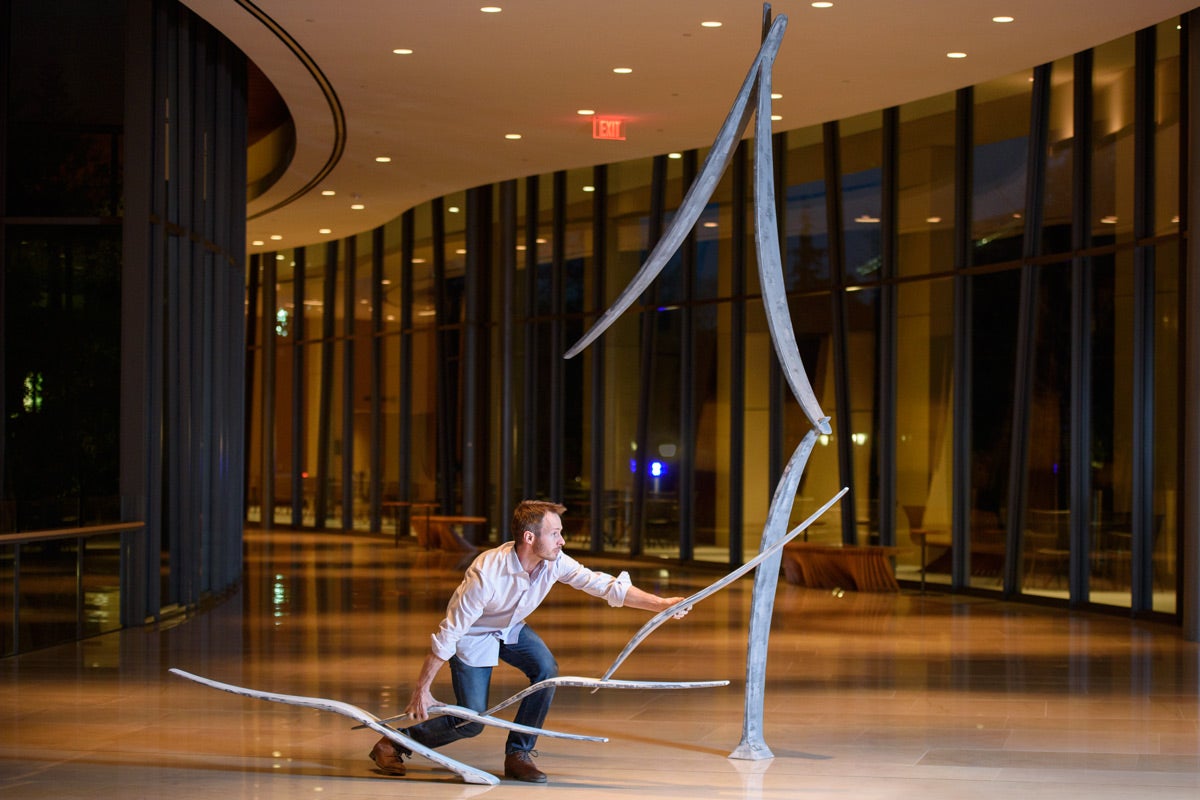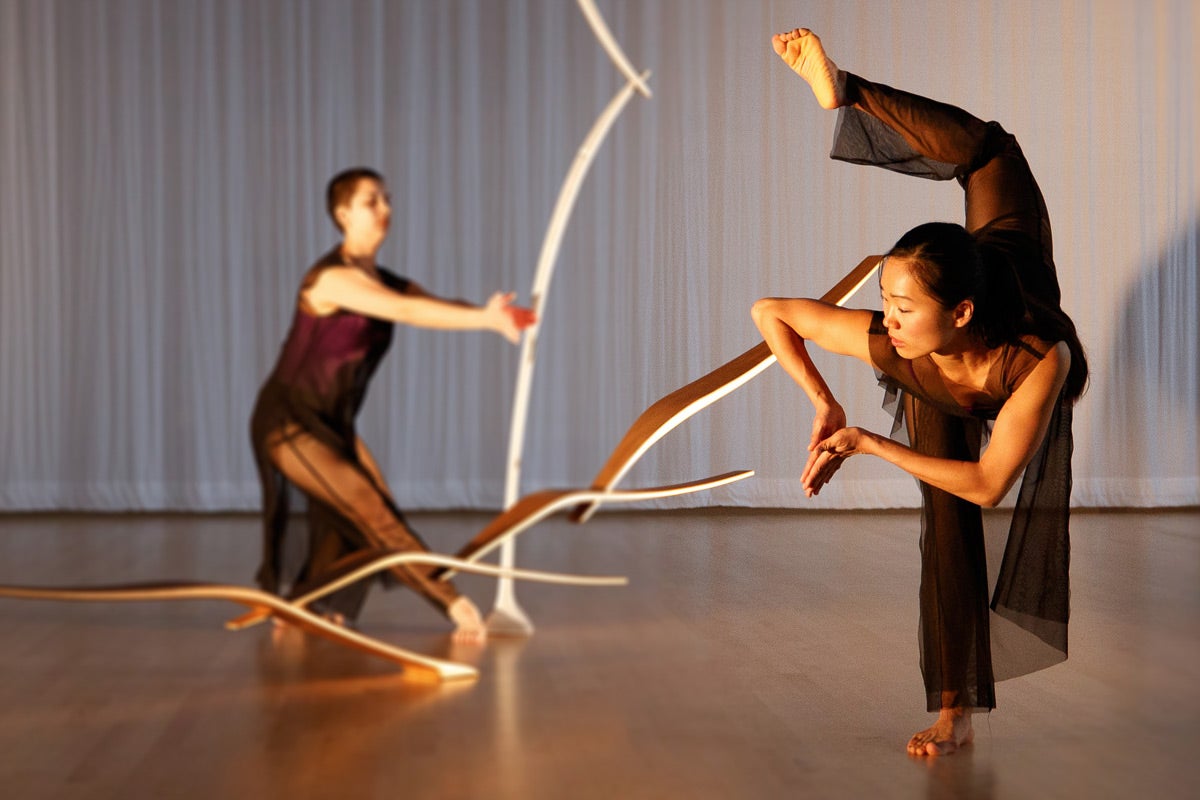Stanford alum returns to campus as visiting artist to explore connections between his art and other disciplines
Sculptor Will Clift creates multiple intersections with a range of disciplines, including dance and music in a multimedia production in Bing Concert Hall’s Gunn Atrium.
When artist Will Clift, BS ’02, MS ’03, was at Stanford, his course load included classes on nearly everything but making art. As an undergraduate he majored in integrative design, an individually designed program that combined engineering, philosophy and psychology. He then earned a master’s degree in management science and engineering. With the exception of an introductory drawing course, he rarely got near the studio art classrooms. Yet, just three years after leaving Stanford, Clift was a full-time sculptor with several group and solo exhibitions on his resume.

Sculptor Will Clift adjusts the placement of his sculpture before a rehearsal at the Bing Concert Hall. (Image credit: L.A. Cicero)
His career took off in part because of what he was able to adapt from his studies to his interest in sculpture, including sneaking into the Product Realization Lab to make a new work on his own, or finding a way to justify an abstract sculpture as a class project.
“I pulled insights that I learned in very disparate classes into my sculpture work at the time, from principles of engineering to the psychology of perception,” Clift said. “And from my master’s work, business strategies that could work as well for a solo sculptor as it could for someone in management consulting.”
In early 2016, Clift was invited back to campus by the Office of the Associate Dean for the Advancement of the Arts to explore intersections between his sculpture and other disciplines as a visiting artist at large.
The product of one of Clift’s intersections from his visiting artist experience is In a Winter Garden. The contemplative performance for music, dance and sculpture is scheduled for Feb. 4 in the Bing Concert Hall Gunn Atrium. The work is a collaboration between Clift, dance lecturer Diane Frank and Music Department chair Jaroslaw Kapuscinski. Three performances, at 1:30 p.m., 5:30 p.m. and 6:30 p.m., each running about 30 minutes in length, are free and open to the public. Supported by Stanford Arts, Stanford Live and the departments of Music, Art and Art History, and Theater and Performance Studies, the production is also part of the 2017 Pan-Asian Music Festival presented by the Center for East Asian Studies.
Clift continues to collaborate with materials science and civil engineering faculty on new materials with applications in both the arts and non-art arenas, such as the construction and automotive industries, in his Santa Fe studio. Similarly, meetings with researchers the Virtual Human Interaction Lab and the School of Medicine may inform his work moving forward.
“In recent years I’ve expanded my work beyond wood and steel, adapting materials such as carbon fiber composite from industries like aerospace, in order to overcome barriers to exploring the relationships between form, gravity and balance,” said Clift about his material experiments.
Dance + music + sculpture
At Stanford and throughout Clift’s career, he has explored, in his words, “gesture in sculpture through the interaction of form and balance. This interaction has become my medium, as much as any physical material.”
The spark for that exploration likely occurred when he was a young child playing with wooden blocks that he assembled into increasingly tall towers and dramatically cantilevered structures, pushing the constructions’ limits until they came crashing down. He says, “I’ve never really stopped doing this. My sculptures consist of intersecting parts that stand or suspend together in equilibrium. No part is extraneous, and the delicacy of this balance reveals the fine line between weight and weightlessness, motion and stillness. I’m trying to capture the moment between breathing in and breathing out, between being grounded and taking flight – the pure potential of movement that has not quite commenced.”
Given the nature of his work, a project involving gesture and movement is a natural intersection for Clift.

Undergraduates Sarah Ribeiro-Broomhead and Cora Cliburn perform In a Winter Garden with a sculpture by Will Clift. (Image credit: Frank Chen)
The site-specific collaboration In a Winter Garden in the Bing atrium investigates the shared signature elements of Clift’s large-scale sculptures, Frank’s site-specific choreography and Kapuscinski’s music: intervals of balance, imbalance and breathed connection within an ever-shifting environment.
The performance explores Japanese aesthetics, particularly the concept of ma. As Kapuscinski explains: “Unlike in Western cultures that focus on objects or events, the Japanese pay great attention to the time and space in between. Ma is this interval that appears in our imagination as we traverse a moment of sound or observe the dimensions of a place. It is the inner breath of a dance movement and the tension between elements of a sculpture. In our work these seemingly empty measures will be imbued by slowly changing sound and silence.”
The winter sounds incorporated in the score were recorded by Japanese environmental sound artist Nao Nishihara in the Tohoku region of Japan after the 2011 earthquake and tsunami. Japanese musician Ko Ishikawa, a master of the sho, an ancient Japanese wind instrument, will perform, and seven dancers will, as Frank describes it, “explore the possibilities within a landscape of interlocking sculptural forms, not merely moving through it but actively creating and changing the sculptural elements in relation to the space, both configuring and traversing the permutations of that sculptural and sonic world.”
The dancers are undergraduates Cora Cliburn, Jessica Fry, Sarah Ribeiro-Broomhead, Meg McNulty and Sydney Maly; political history doctoral candidate Glory Liu; and alumna Katharine Hawthorne, BS ’10, a physics graduate with honors and a dance minor, who, like Clift, has built an artistic career from her science background and other Stanford interdisciplinary experiences.
“It is just such a pleasure to collaborate with Will and Jarek,” said Frank. “We all have, as individual artists, a predisposition toward what I would call the animating architecture of our respective forms. It’s both a felt sense and an intellectual process, creatively.”
Reflecting on the natural intersection of his sculpture work with dance and music, Clift says, “We as humans intuitively understand balance through our own bodies, ever since we learned to stand, to walk, to dance. In each of my works, I hope that the balance between movement and stillness evokes a sense both of harmony and of playfulness and wonder.”
Thinking about his visiting artist experience, he says, “One of the best lessons of my time at Stanford, both as a student and now as a visiting artist, is that innovation, whether in tech or in medical sciences or in the visual arts, can come, and maybe most often does come, from unexpected directions, from cross-pollination.”
